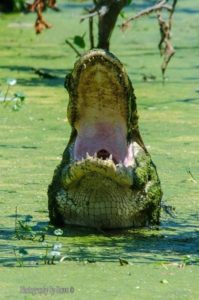It’s spring in the Lowcountry. It’s starting to get warmer and that means our large local alligator population is on the move all over the area, looking for love. In fact, gators are being seen by folks all over Beaufort right now.
This time of year brings warmer weather and our gators become more active in their mating season with courtships and mating getting underway in April, May and June.
Alligators become more active and visible when temperatures rise and their metabolism increases. This time of year, Lowcountry gators are more active, males looking for females, displaying, showing themselves to other alligators…and often to us humans.
As we’re out enjoying the warmer weather, so are they. And, folks are even finding them in the streets, their driveways, and sometimes even on their front porches.
On local golf courses, beaches, in the marshes, practically anywhere and everywhere there is water…gators and locals cross paths quite often.
Because alligators control their body temperature by basking in the sun, they may be easily observed. However, you need to keep your distance if you see one. And, never feed alligators because it is both dangerous AND illegal.
In fact, help us let visiting tourists know this and that feeding them is illegal in our state. Alligators fed by humans will eventually lose their natural fear of us and this could bring on some serious problems.
Alligators usually are not aggressive toward humans, but they are very dangerous. Unprovoked attacks by alligators smaller than 5 feet are rare, but unusual behavior does occur. Single bites usually are made by alligators that are less than 8 feet long. Most bites occur in Florida, but attacks also have been documented in South Carolina, Louisiana, Texas, Georgia, and Alabama.
Beaufort has had its share, too.
There’s a lot of ’em Lowcountry gators

There are lots of gators in Beaufort. South Carolina is estimated to house approximately 100,000 alligators, and most of them call the Lowcountry home.
According to the South Carolina Department of Natural Resources website, alligators are federally classified as “threatened due to similarity of appearance” to other endangered crocodilians. The classification provides federal protection for alligators but allows state-approved programs for management and control.
After mating season, a female lays a single clutch of 30 to 50 eggs in a mound of vegetation during early June to mid-July. In late August or early September, 9- to 10-inch hatchlings are liberated from the nest by the female. The female may defend and stay with her hatchlings for up to a year, gradually removing herself as caregiver as the next breeding season approaches.
When Beaufort and the sea islands start to heat up, Lowcountry gators are on the move….
READ: Fines for feeding gators increased in South Carolina










